 |

On May 1st, 2018, Scientific AmeriKen hit an exciting milestone - $100.00 earned with Google Adsense (the amount that allows for payment) and a 3-year-long study had reached its conclusion. The ad-banner has long been a staple for advertisement on the web since the earliest days, and still prevails over alternative strategies that include pop-up windows, dynamic overlays, and re-directs. The purpose of this experiment is to learn more about the advertising realm. Although there are many focus points in the research to be presented, the primary goal is to better understand the click-bait websites and answer the question if they actually generate income!

Ad-laden websites are springing up all around no doubt an indicator of success. The hypothesis of this experiment is that pages such as these will drive home more clicks on the banners than standard ad-placement.

The experiment started three years ago with the development of ScientificAmeriKen OddCures, an ad-intensive click-bait like page, but no doubt also has extremely valuable information curated by Scientific AmeriKen himself! As control for less intensive advertisements, Scientific AmeriKen's most commonly visited experiments each received a banner advertisement. Among these include Aluminum Foil Burn or Melt, Penny Cleaning, and the most visited experiment, Mixing Sugar and Vinegar, which incidentally is the most nothing happens experiment in the history of Scientific AmeriKen. Data was then collected from May 2015 to May 2018, and data were analyzed using Microsoft Excel.

Initially we analyzed total page views and click rate (Figures below). Through the three years the collective advertisement pages received roughly 2,000 page views per month, with periodic declines during summer months indicative of a student following. Clicks per 1000 views started out a decent rate, but then declined half way through the experiment - seemingly coinciding with a new push by Google to have website owners switch to secure HTTPs websites.

Further analysis of the average monthly click rate before and after the implementation of Google's new rules in January of 2017 (Figure below), reveals that click rate was indeed significantly lower.

Next we investigated click rate based on country (Figure below, left), which seemed to indicate that countries with a funny English accent were more susceptible to clicking (including the United Kingdom, Australia, South Africa, and India). We also found that advertisements that are small, near-perfect squares were far superior in driving home clicks (Figure below, right).

Next, we examined how platform type affected click rate (Figures below). Interestingly the amount of page views were split predominantly between desktop computers and smart phones, yet smart phone users were far less likely to click on the advertisements. Just another reason Scientific AmeriKen can't wait for that cell phone fad to go away!

Finally, our data revealed our ad-intensive Odd Cures pages far outperformed the classic experiment pages in terms of click rate (Figure below, left). Unfortunately driving traffic to these pages proved to be somewhat difficult and the Odd Cures pages were far from the best earners, with the strangely popular Sugar versus Vinegar experiment taking top honors.


Although not as enriching as other click-bait ads, the research presented here does show the effectiveness of ad-laden websites as clicks happened nearly 6 times more often! However, driving traffic to the site remains important - perhaps a new experiment will compare link strategies such as: "Visit Scientific AmeriKen's ODD CURES" versus "You'll never believe what this Gen-Xer did for sore red eyes! (CLICK HERE)". An interesting finding from this study was also the impact of new Google policies regarding a secure server (https). Although warnings from Google suggested less traffic would be directed to non-secure websites through their search engine, the number of page views did not decline. Instead, click rate lowered, which is unclear why that would be the case - Scientific AmeriKen can only surmise that a large international plot by google is underfoot to defraud small web owners out of billions of dollars! Other findings were also interesting including the lack of click desire in smart phone users. Perhaps one explanation is the smaller screen forces users to zoom in on only the content therefore taking the banners out of sight. The success of this study is prompting continuance on the three most visited experiments and Odd-Cures pages, although Scientific AmeriKen is proud to announce the rest of the site will remain ad-free! That being said, now $100 richer - Scientific AmeriKen can't wait until that next big payday three years from now!
Visit ScienceChatForum.com to discuss this experiment and any science really! (Click here)
|
 |
|



